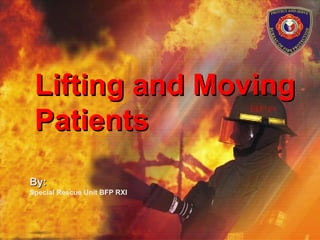
C lifting and moving_patients final
- 1. By:By: Special Rescue Unit BFP RXI Lifting and MovingLifting and Moving PatientsPatients
- 2. Moving VictimsMoving Victims Moving injured victim likely to cause furtherMoving injured victim likely to cause further injuryinjury In most cases wait for professional helpIn most cases wait for professional help May have to move victim to protect fromMay have to move victim to protect from danger at scenedanger at scene May have to move victim to flat surface toMay have to move victim to flat surface to provide CPRprovide CPR
- 3. Indication of emergencyIndication of emergency rescuerescue Back injury is hazard for First RespondersBack injury is hazard for First Responders To minimize risks, use good bodyTo minimize risks, use good body mechanicsmechanics Body mechanics are principles of usingBody mechanics are principles of using your body safelyyour body safely
- 4. Body Mechanics and Lifting TechniquesTechniques Know your physical ability and limitationsKnow your physical ability and limitations Plan the liftPlan the lift Ensure you have a good gripEnsure you have a good grip Test the loadTest the load Position your feet properly before starting liftPosition your feet properly before starting lift Lift with your legs, not with your backLift with your legs, not with your back Keep patient’s weight close to your bodyKeep patient’s weight close to your body Avoid twisting your back during the liftAvoid twisting your back during the lift Communicate clearly with your partner andCommunicate clearly with your partner and other EMS providersother EMS providers
- 5. Patient PositioningPatient Positioning Reposition a patient only when necessaryReposition a patient only when necessary Reposition a breathing, unresponsive, non-Reposition a breathing, unresponsive, non- trauma patient in the recovery positiontrauma patient in the recovery position Don’t move or reposition a trauma patientDon’t move or reposition a trauma patient unless necessary to treat life-threateningunless necessary to treat life-threatening conditioncondition Allow responsive patient to assumeAllow responsive patient to assume comfortable positioncomfortable position
- 8. Skill:Skill: Recovery PositionRecovery Position (Modified HAINES)(Modified HAINES)
- 16. Log RollLog Roll Use log roll to move patient from prone toUse log roll to move patient from prone to supinesupine Three to five rescuers are needed to safelyThree to five rescuers are needed to safely roll patientroll patient For trauma patient with spinal injury,For trauma patient with spinal injury, stabilize head in line with bodystabilize head in line with body
- 17. Log Roll continuedLog Roll continued 1.1. The rescuer at the patient’s head holds the head inThe rescuer at the patient’s head holds the head in line with the body as two or three additionalline with the body as two or three additional rescuers take position with hands at the patient’srescuers take position with hands at the patient’s lower and upper leg, hip and torso, and shoulder.lower and upper leg, hip and torso, and shoulder. 2.2. At the direction of the responder at the head, theAt the direction of the responder at the head, the rescuers in unison roll the patient toward them, withrescuers in unison roll the patient toward them, with the head held in line and the spine straight.the head held in line and the spine straight. 3.3. The rescuers complete the log roll, positioning theThe rescuers complete the log roll, positioning the patient on the back with head and neck still in linepatient on the back with head and neck still in line with the body.with the body.
- 19. Risk of Spinal InjuryRisk of Spinal Injury • Moving patient quickly risks aggravating aMoving patient quickly risks aggravating a spinal injuryspinal injury • Keep head and neck in line with spineKeep head and neck in line with spine • It is impossible to protect spine whileIt is impossible to protect spine while removing patient from a vehicle quicklyremoving patient from a vehicle quickly
- 20. Extrication from VehiclesExtrication from Vehicles First Responders may be trained inFirst Responders may be trained in rapid extrication using cervical collarrapid extrication using cervical collar and inline stabilization of head/neckand inline stabilization of head/neck Follow local protocolFollow local protocol Wait for EMTs trained in specialWait for EMTs trained in special extrication techniquesextrication techniques
- 21. One-Rescuer EmergencyOne-Rescuer Emergency DragsDrags Pull/drag patient in direction of long axisPull/drag patient in direction of long axis of bodyof body Don’t drag patient sideways, and avoidDon’t drag patient sideways, and avoid twisting neck/trunktwisting neck/trunk Never pull head away from neck/shouldersNever pull head away from neck/shoulders Risk of spinal injury can be minimized byRisk of spinal injury can be minimized by using a blanket, rug, board, etcusing a blanket, rug, board, etc Choice of move depends on materials atChoice of move depends on materials at hand, patient’s condition, and situationhand, patient’s condition, and situation
- 22. One-Rescuer EmergencyOne-Rescuer Emergency DragsDrags Clothing DragClothing Drag Blanket DragBlanket Drag Shoulder DragShoulder Drag Firefighter’s DragFirefighter’s Drag Upper Extremity DragUpper Extremity Drag Upper Extremity Drag for Rapid ExtricationUpper Extremity Drag for Rapid Extrication
- 23. Emergency CarriesEmergency Carries Used when patient must be movedUsed when patient must be moved immediatelyimmediately One or more rescuers may carry patientOne or more rescuers may carry patient Method used depends on patient’s size,Method used depends on patient’s size, condition and situation:condition and situation: Walking assistWalking assist Cradle carryCradle carry Multiple-rescuer techniques are safer/lessMultiple-rescuer techniques are safer/less stressfulstressful
